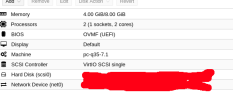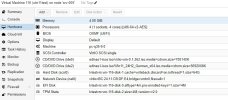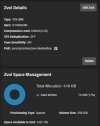Hello Everyone,
I'm trying to install a Win 11 VM in Proxmox VE 8.3.2. As soon as I select
I tried all different kind of settings for CPU and Display but I can't get it running. When I select
This is the conf:
Do you have any idea how I could solve this issue? I would appreciate any help!
Best,
Jochen
I'm trying to install a Win 11 VM in Proxmox VE 8.3.2. As soon as I select
Bios: OVMF (UEFI) I get an error when I start the VM: Display output is not active. I tried all different kind of settings for CPU and Display but I can't get it running. When I select
SeaBIOS the VM starts and the Windows installation process begins. However, it stops when it checks the system requirements and fails (probably because of the SeaBIOS).This is the conf:
Code:
agent: 0
bios: ovmf
boot: order=scsi0;ide0;ide2;net0
cores: 2
cpu: host
efidisk0: pve-dwdesktop:0.0.0.scsi-36589cfc00000047ecf8717cc9364c454,efitype=4m,size=2>
ide0: edinas1-isos:iso/Win11_24H2_German_x64.iso,media=cdrom,size=5692008K
ide2: edinas1-isos:iso/virtio-win-0.1.262.iso,media=cdrom,size=708140K
machine: pc-q35-9.0
memory: 4096
meta: creation-qemu=9.0.2,ctime=1735931039
name: dwdesktop
net0: virtio=BC:24:11:3C:49:FF,bridge=vmbr0,firewall=1
numa: 0
ostype: win11
scsi0: pve-dwdesktop:0.0.0.scsi-36589cfc00000047ecf8717cc9364c454,cache=writeback,disc>
scsihw: virtio-scsi-single
smbios1: uuid=da92b03c-946d-4f0b-af17-8a2973071f52
sockets: 1
tpmstate0: pve-dwdesktop:0.0.0.scsi-36589cfc00000047ecf8717cc9364c454,size=268435472K,>
vga: virtio
vmgenid: 85774920-31f5-4fdc-94b7-ce0fca231cb9Do you have any idea how I could solve this issue? I would appreciate any help!
Best,
Jochen





